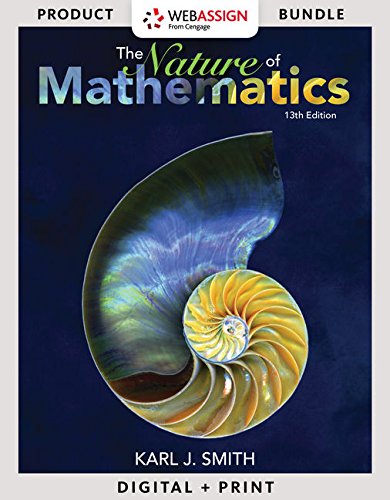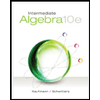
(a)
To simplify:
The expression
Answer to Problem 1CR
Solution:
The simplified form of the given expression is 3.
Explanation of Solution
Approach:
For positive
Here
The result on logarithm is given as,
Calculation:
Consider the given expression,
Now,
The given expression can be simplified as,
The simplified form of the given expression is 3.
(b)
To simplify:
The expression
Answer to Problem 1CR
Solution:
The simplified form of the given expression is
Explanation of Solution
Approach:
For positive
Here
The results on logarithm are given as,
Also,
Calculation:
Consider the given expression,
The given expression can be simplified as,
By results on logarithm,
The simplified form of the given expression is
Want to see more full solutions like this?
Chapter 10 Solutions
Bundle: Nature Of Mathematics, Loose-leaf Version, 13th + Webassign Printed Access Card For Smith's Nature Of Mathematics, 13th Edition, Single-term
- The managing director of a consulting group has the accompanying monthly data on total overhead costs and professional labor hours to bill to clients. Complete parts a through c. Question content area bottom Part 1 a. Develop a simple linear regression model between billable hours and overhead costs. Overhead Costsequals=212495.2212495.2plus+left parenthesis 42.4857 right parenthesis42.485742.4857times×Billable Hours (Round the constant to one decimal place as needed. Round the coefficient to four decimal places as needed. Do not include the $ symbol in your answers.) Part 2 b. Interpret the coefficients of your regression model. Specifically, what does the fixed component of the model mean to the consulting firm? Interpret the fixed term, b 0b0, if appropriate. Choose the correct answer below. A. The value of b 0b0 is the predicted billable hours for an overhead cost of 0 dollars. B. It is not appropriate to interpret b 0b0, because its value…arrow_forward3. Consider the polynomial equation 6-iz+7z2-iz³ +z = 0 for which the roots are 3i, -2i, -i, and i. (a) Verify the relations between this roots and the coefficients of the polynomial. (b) Find the annulus region in which the roots lie.arrow_forwardWrite the equation of the trigonometric function shown in the graph. LO 5 4 3 2 1 y -5 -5 4 8 8 500 -1 -2 -3 -4 -5 x 5 15л 5л 25л 15л 35π 5л 4 8 2 8 4 8arrow_forward
- c) Using only Laplace transforms solve the following Samuelson model given below i.e., the second order difference equation (where yt is national income): - Yt+2 6yt+1+5y₁ = 0, if y₁ = 0 for t < 0, and y₁ = 0, y₁ = 1 1-e-s You may use without proof that L-1[s(1-re-s)] = f(t) = r² for n ≤tarrow_forward5. 156 m/WXY = 59° 63 E 7. B E 101 C mFE = 6. 68° 8. C 17arrow_forwardScoring: MATH 15 FILING /10 COMPARISON /10 RULER I 13 Express EMPLOYMENT PROFESSIONALS NAME: SKILLS EVALUATION TEST- Light Industrial MATH-Solve the following problems. (Feel free to use a calculator.) DATE: 1. If you were asked to load 225 boxes onto a truck, and the boxes are crated, with each crate containing nine boxes, how many crates would you need to load? 2. Imagine you live only one mile from work and you decide to walk. If you walk four miles per hour, how long will it take you to walk one mile? 3. Add 3 feet 6 inches + 8 feet 2 inches + 4 inches + 2 feet 5 inches. 4. In a grocery store, steak costs $3.85 per pound. If you buy a three-pound steak and pay for it with a $20 bill, how much change will you get? 5. Add 8 minutes 32 seconds + 37 minutes 18 seconds + 15 seconds. FILING - In the space provided, write the number of the file cabinet where the company should be filed. Example: File Cabinet #4 Elson Co. File Cabinets: 1. Aa-Bb 3. Cg-Dz 5. Ga-Hz 7. La-Md 9. Na-Oz 2. Bc-Cf…arrow_forwardpart 3 of the question is: A power outage occurs 6 min after the ride started. Passengers must wait for their cage to be manually cranked into the lowest position in order to exit the ride. Sine function model: where h is the height of the last passenger above the ground measured in feet and t is the time of operation of the ride in minutes. What is the height of the last passenger at the moment of the power outage? Verify your answer by evaluating the sine function model. Will the last passenger to board the ride need to wait in order to exit the ride? Explain.arrow_forwardIf you were asked to load 225 boxes onto a truck, and the boxes are crated, with each crate containing nine boxes, how many crates would you need to load?arrow_forwardForce with 800 N and 400 N are acting on a machine part at 30° and 60°, respectively with the positive x axisarrow_forward2. The duration of the ride is 15 min. (a) How many times does the last passenger who boarded the ride make a complete loop on the Ferris wheel? (b) What is the position of that passenger when the ride ends?arrow_forwardFind the accumulated amount A, if the principal P is invested at an interest rate of r per year for t years. (Round your answer to the nearest cent.) P = $13,000, r = 6%, t = 10, compounded quarterly A = $ 31902 Need Help? Read It Watch It Viewing Saved Work Revert to Last Response SUBMIT ANSWER O/6.66 Points] DETAILS MY NOTES TANAPCALC10 5.3.003. EVIOUS ANSWERS ASK YOUR TEACHER PRACTICE ANOTHER Find the accumulated amount A, if the principal P is invested at an interest rate of r per year for t years. (Round your answer to the nearest cent.) P = $140,000, r = 8%, t = 8, compounded monthly A = $259130.20 X Need Help? Read It Watch Itarrow_forwardFind the present value of $20,000 due in 3 years at the given rate of interest. (Round your answers to the nearest cent.) (a) 2%/year compounded monthly (b) 5%/year compounded daily $ Need Help? Read It Watch It SUBMIT ANSWER [-/6.66 Points] DETAILS MY NOTES TANAPCALC10 5.3.009. ASK YOUR TEACHER PRACTICE ANC Find the accumulated amount after 3 years if $4000 is invested at 3%/year compounded continuously. (Round your answer to the nearest cent.) Need Help? Read It Watch Itarrow_forwardarrow_back_iosSEE MORE QUESTIONSarrow_forward_ios


 College Algebra (MindTap Course List)AlgebraISBN:9781305652231Author:R. David Gustafson, Jeff HughesPublisher:Cengage Learning
College Algebra (MindTap Course List)AlgebraISBN:9781305652231Author:R. David Gustafson, Jeff HughesPublisher:Cengage Learning Algebra for College StudentsAlgebraISBN:9781285195780Author:Jerome E. Kaufmann, Karen L. SchwittersPublisher:Cengage Learning
Algebra for College StudentsAlgebraISBN:9781285195780Author:Jerome E. Kaufmann, Karen L. SchwittersPublisher:Cengage Learning Intermediate AlgebraAlgebraISBN:9781285195728Author:Jerome E. Kaufmann, Karen L. SchwittersPublisher:Cengage Learning
Intermediate AlgebraAlgebraISBN:9781285195728Author:Jerome E. Kaufmann, Karen L. SchwittersPublisher:Cengage Learning




